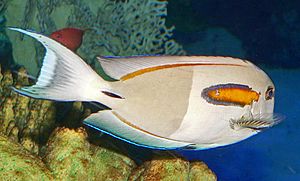Orange-band surgeonfish facts for kids
Quick facts for kids Orange-band surgeonfish |
|
|---|---|
 |
|
| Conservation status | |
| Scientific classification | |
| Synonyms | |
|
The Acanthurus olivaceus, also known as the orange-band surgeonfish or orange-shoulder surgeonfish, is a type of fish. It belongs to a group of fish called Acanthuridae, which are known as surgeonfishes. These fish live in the warm, tropical waters of the Indo-west Pacific Ocean.
Contents
What the Orange-Band Surgeonfish Looks Like
The orange-band surgeonfish has a body that is deep and flat from side to side. It looks like an oval shape. This fish is usually more than twice as long as it is deep. It can grow up to about 35 centimeters (14 inches) long. However, most of them are around 25 centimeters (10 inches) long.
Both its top fin (dorsal fin) and bottom fin (anal fin) are long and low. They reach almost to its tail. The dorsal fin has nine stiff spines and 23 to 25 soft rays. The anal fin has three spines and 22 to 24 soft rays. Its tail fin is shaped like a crescent moon. The tips of the tail get longer as the fish gets older.
Adult surgeonfish are usually grayish-brown. They often have a clear vertical line that divides their body. The front half is lighter, and the back half is darker. A special orange bar with a dark purplish-black edge is found right behind its gill cover. You can also see blue and orange lines at the base of its fins.
Like all surgeonfish, this species has two sharp, scalpel-like scales. These scales stick out from the narrow part of its body just before the tail (called the caudal peduncle). Older male fish have a rounded snout that helps tell them apart from females. Young surgeonfish are bright yellow.
Where the Orange-Band Surgeonfish Lives
This fish is found in the warm parts of the eastern Indian Ocean and the western Pacific Ocean. Its home stretches from Christmas Island and the Cocos Keeling Islands all the way to southern Japan. It also lives near Australia (Western, Northern, and Eastern parts), Indonesia, the Philippines, and Hawaii.
You can often find these fish near coral reefs. They prefer the outer edges of reefs and places that are more open to the ocean currents. Adult fish usually live alone. Sometimes, they join groups of other fish. They can be found at depths of about 9 to 46 meters (30 to 150 feet). Young surgeonfish, however, live in shallower, more protected waters in small groups.
What the Orange-Band Surgeonfish Eats
The orange-band surgeonfish eats tiny bits of dead plants and animals (called detritus). It also eats algae that grows on the seabed. This includes a thin layer of tiny plant-like organisms called diatoms and stringy algae found on sand and rocks.
These fish often swim in schools with other fish like parrotfish and tangs. These fish all eat similar things. Their grazing, or eating algae, is very important for keeping the reef healthy. By eating too much algae, they help keep the rocks clear. This allows baby corals to find a good place to grow and settle. This process helps keep the variety of life (biodiversity) on the reef balanced. The surgeonfish can also change its body color from dark to light very quickly.
Conservation Status
The orange-band surgeonfish lives across a large area in the tropical Indo-Pacific. It is quite common to find them. Sometimes, you might see them in fish markets or in pet stores for aquariums. However, they are not a main target for large fishing industries.
No major threats to this fish have been found. Because of this, the International Union for the Conservation of Nature has listed its conservation status as "least concern." This means they are not currently worried about this species becoming endangered.
See also
 In Spanish: Acanthurus olivaceus para niños
In Spanish: Acanthurus olivaceus para niños


